On Lake Michigan, stunning ice formations named after a breakfast favorite meal emerge, creating spectacular views recently along the Chicago waterfront.
The current Great Lakes ice coverage is 21.9 percent, which is the highest for this date in the recent six years (tied with 2019). Lake Michigan is likewise ice-free, with a covering of roughly 20%, which is close to the norm thus far. Because of the freezing weather throughout parts of the northern US this time of year, oddities like ice pancakes, ice nibbles, and ice balls appear.
But what exactly are ice pancakes, and how do they come to be? Here's all you need to know about the winter phenomena.
Mother Nature is a cook. Pancake ice floating on lake Michigan. pic.twitter.com/yLOOMMsbNQ
— Indranil Roy (@neelroyy) January 20, 2022
According to The Weather Channel, ice pancakes start as a thin ice coating on the water's surface before collecting into circular disks with diameters ranging from one to ten feet. Ice pancakes, like its namesake, are round flat discs of ice that appear precisely as you'd expect.
They're ubiquitous in the Arctic, but they usually don't show up in the Lower 48 until temperatures drop far below freezing for many days.
A Rare Phenomenon
Lake Michigan's ice pancakes are a feast for the eyes this time of year. 😍
— Choose Chicago (@ChooseChicago) January 20, 2022
📸: lynda_myszkowski via IG#CaptureChicagoExcitement pic.twitter.com/xpvnitF0r6
According to the National Snow & Ice Data Center, loose ice crystals will develop into a pancake-like shape if the body of water has a turbulent current. "Raised edges or ridges on the perimeter" are typical on pancake ice, which develop when the "pancakes" collide.
"Pancake ice is unique in that it requires a precise temperature to create. Andrea Vander Woude, a researcher at the National Oceanic and Atmospheric Administration's Great Lakes Environmental Research Laboratory, told Block Club Chicago that it usually occurs slightly below freezing and in regions with a small wave motion.
They're "small little floating icebergs," she said, and they move swiftly.
According to National Geographic, ice pancakes are most prevalent in frigid waters, but they may be made anywhere given the right circumstances.
However, it is not the same as conventional ice. According to National Geographic, Ted Scambos, a principal scientist at the National Snow and Ice Data Center, it's "more like a slush."
Related Article : Melting of Enormous 'Mega-Iceberg' Released 152 Billion Tons of Water Into the Ocean
Ice Pancakes

Ice pancakes are phenomena in which discs of ice ranging in width from 20 to 200 cm are created, providing a spectacular sight.
They are a somewhat uncommon occurrence in frigid seas and lakes. They are most commonly spotted in the Baltic Sea and near Antarctica, although they may also be found on the United States' and Canada's Great Lakes.
They can develop in two ways and require certain exact circumstances to form.
The discs are formed when waves cause growing bits of ice to hit against one other, rounding their edges as they freeze and expand in oceans, seas, and lakes. The knocking causes splashing water to freeze and join the rim, forming little rims on the edges.
They are also thought to originate when river foam begins to freeze and joins together before being drawn into an eddy (a swirling movement of water) and forming into a circular shape. As further shards of frozen foam and ice collide with the growing disc, they stick to it and expand it.
Ice pancakes may appear to be solid discs, but they are frequently mushy and easily break apart.
For similar news, don't forget to follow Nature World News!
© 2025 NatureWorldNews.com All rights reserved. Do not reproduce without permission.





